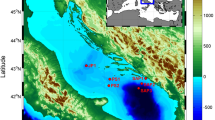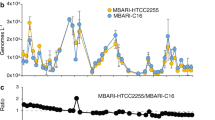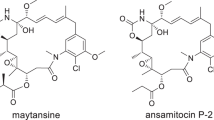Abstract
Although competition, niche partitioning, and spatial isolation have been used to describe the ecology and evolution of macro-organisms, it is less clear to what extent these principles account for the extraordinary levels of bacterial diversity observed in nature. Ecological interactions among bacteria are particularly challenging to address due to methodological limitations and uncertainties over how to recognize fundamental units of diversity and link them to the functional traits and evolutionary processes that led to their divergence. Here we show that two closely related marine actinomycete species can be differentiated based on competitive strategies. Using a direct challenge assay to investigate inhibitory interactions with members of the bacterial community, we observed a temporal difference in the onset of inhibition. The majority of inhibitory activity exhibited by Salinispora arenicola occurred early in its growth cycle and was linked to antibiotic production. In contrast, most inhibition by Salinispora tropica occurred later in the growth cycle and was more commonly linked to nutrient depletion or other sources. Comparative genomics support these differences, with S. arenicola containing nearly twice the number of secondary metabolite biosynthetic gene clusters as S. tropica, indicating a greater potential for secondary metabolite production. In contrast, S. tropica is enriched in gene clusters associated with the acquisition of growth-limiting nutrients such as iron. Coupled with differences in growth rates, the results reveal that S. arenicola uses interference competition at the expense of growth, whereas S. tropica preferentially employs a strategy of exploitation competition. The results support the ecological divergence of two co-occurring and closely related species of marine bacteria by providing evidence they have evolved fundamentally different strategies to compete in marine sediments.
Similar content being viewed by others
Log in or create a free account to read this content
Gain free access to this article, as well as selected content from this journal and more on nature.com
or
References
Acinas SG, Klepac-Ceraj V, Hunt DE, Pharino C, Ceraj I, Distel DL et al. (2004). Fine-scale phylogenetic architecture of a complex bacterial community. Nature 430: 551–554.
Ahmed L, Jensen PR, Freel KC, Brown R, Jones AL, Kim BY et al. (2013). Salinispora pacifica sp. nov., an actinomycete from marine sediments. Antonie Van Leeuwenhoek 103: 1069–1078.
Anderson MJ . (2001). A new method for non-parametric multivariate analysis of variance. Austral Ecol 26: 32–46.
Bellenger JP, Wichard T, Kustka AB, Kraepiel AML . (2008). Uptake of molybdenum and vanadium by a nitrogen-fixing soil bacterium using siderophores. Nat Geosci 1: 243–246.
Berdy J . (2005). Bioactive microbial metabolites. A personal view. J Antibiot 58: 1–26.
Bibb M . (1996). The regulation of antibiotic production in Streptomyces coelicolor A3 (2). Microbiology 142: 1335–1344.
Blunt J, Munro M, Laatsch H . (2006) AntiMarin Database. University of Canterbury: Christchurch, New Zealand.
Case TJ, Gilpin ME . (1974). Interference competition and niche theory. Proc Natl Acad Sci USA 71: 3073–3077.
Chao L, Levin BR . (1981). Structured habitats and the evolution of anticompetitor toxins in bacteria. Proc Natl Acad Sci USA 78: 6324–6328.
Cohan F . (2002). What are bacterial species? Annu Rev Microbiol 56: 457–487.
Coley PD, Bryant JP, Chapin FS III . (1985). Resource availability and plant antiherbivore defense. Science 230: 895–899.
Cordero OX, Wildschutte H, Kirkup B, Proehl S, Ngo L, Hussain F et al. (2012). Ecological populations of bacteria act as socially cohesive units of antibiotic production and resistance. Science 37: 1228–1231.
Cordero OX, Polz MF . (2014). Explaining microbial genomic diversity in light of evolutionary ecology. Nat Rev Microbiol 12: 263–273.
Czárán TL, Hoekstra RF, Pagie L . (2002). Chemical warfare between microbes promotes biodiversity. Proc Natl Acad Sci USA 99: 786–790.
Farrell DJ, Putnam SD, Biedenbach DJ, Moro L, Bozzella R, Celasco G et al. (2011). In vitro activity and single-step mutational analysis of rifamycin SV tested against enteropathogens associated with traveler's diarrhea and Clostridium difficile. Antimicrob Agents Chemother 55: 992–996.
Fenical W, Jensen PR . (2006). Developing a new resource for drug discovery: marine actinomycete bacteria. Nat Chem Biol 2: 666–673.
Ferris MJ, Kuhl M, Wieland A, Ward DM . (2003). Cyanobacterial ecotypes in different optical microenvironments of a 68C hot spring mat community revealed by 16 S-23 S rRNA internal transcribed spacer region variation. Appl Environ Microbiol 69: 2893–2898.
Flamholz A, Noor E, Bar-Even A, Liebermeister W, Milo R . (2013). Glycolytic strategy as a tradeoff between energy yield and protein cost. Proc Natl Acad Sci 110: 10039–10044.
Floss H, Yu T . (2005). Rifamycin-mode of action, resistance, and biosynthesis. Chem Rev 105: 621–632.
Fraser C, Hanage WP, Spratt BG . (2007). Recombination and the nature of bacterial speciation. Science 315: 476–480.
Fraser C, Alm EJ, Polz MF, Spratt BG, Hanage WP . (2009). The bacterial species challenge: making sense of genetic and ecological diversity. Science 323: 741–746.
Freel KC, Nam SJ, Fenical W, Jensen PR . (2011). Evolution of secondary metabolite genes in three closely related marine actinomycete species. Appl Environ Microbiol 77: 7261–7270.
Freel KC, Edlund A, Jensen PR . (2012). Microdiversity and evidence for high dispersal rates in the marine actinomycete 'Salinispora pacifica'. Environ Microbiol 14: 480–493.
Freel KC, Millan-Aguinaga N, Jensen PR . (2013). Multilocus sequence typing reveals evidence of homologous recombination linked to antibiotic resistance in the genus Salinispora. Appl Environ Microbiol 79: 5997–6005.
Fuhrman JA . (2009). Microbial community structure and its functional implications. Nature 459: 193–199.
Gilbert JA, Steele JA, Caporaso JG, Steinbrück L, Reeder J, Temperton B et al. (2012). Defining seasonal marine microbial community dynamics. ISME J 6: 298–308.
Gontang EA, Fenical W, Jensen PR . (2007). Phylogenetic diversity of gram-positive bacteria cultured from marine sediments. Appl Environ Microbiol 73: 3272–3282.
Grossart HP, Schlingloff A, Bernhard M, Simon M, Brinkhoff T . (2004). Antagonistic activity of bacteria isolated from organic aggregates of the German Wadden Sea. FEMS Microbiol Ecol 47: 387–396.
Hellweger FL, van Sebille E, Fredrick ND . (2014). Biogeographic patterns in ocean microbes emerge in a neutral agent-based model. Science 345: 1346–1349.
Hibbing ME, Fuqua C, Parsek MR, Peterson SB . (2010). Bacterial competition: surviving and thriving in the microbial jungle. Nat Rev Microbiol 8: 15–25.
Huber JA, Mark Welch DB, Morrison HG, Huse SM, Neal PR, Butterfield DA et al. (2007). Microbial population structures in the deep marine biosphere. Science 318: 97–100.
Hugoni M, Taib N, Debroas D, Domaizon I, Jouan Dufournel I, Bronner G et al. (2013). Structure of the rare archaeal biosphere and seasonal dynamics of active ecotypes in surface coastal waters. Proc Natl Acad Sci USA 110: 6004–6009.
Hunt DE, David LA, Gevers D, Preheim SP, Alm EJ, Polz MF . (2008). Resource partitioning and sympatric differentiation among closely related bacterioplankton. Science 320: 1081–1085.
Hutchinson GE . (1961). The paradox of the plankton. Am Nat 95: 137–145.
Izumi H, Gauthier MEA, Degnan BM, Ng YK, Hewavitharana AK, Shaw PN et al. (2010). Diversity of Mycobacterium species from marine sponges and their sensitivity to antagonism by sponge-derived rifamycin-synthesizing actinobacterium in the genus Salinispora. FEMS Microbiol Lett 313: 33–40.
Jarvis BB . (1995). Secondary metabolites and their role in evolution. An Acad Bras Cienc 67 (Suppl 3): 329–345.
Jauri PV, Bakker MG, Salomon CE, Kinkel LL . (2013). Subinhibitory antibiotic concentrations mediate nutrient use and competition among soil Streptomyces. PLoS One 8: e81064.
Jensen PR, Gontang E, Mafnas C, Mincer TJ, Fenical W . (2005). Culturable marine actinomycete diversity from tropical Pacific Ocean sediments. Environ Microbiol 7: 1039–1048.
Jensen PR, Mafnas C . (2006). Biogeography of the marine actinomycete Salinispora. Environ Microbiol 8: 1881–1888.
Jensen PR, Williams PG, Oh DC, Zeigler L, Fenical W . (2007). Species-specific secondary metabolite production in marine actinomycetes of the genus Salinispora. Appl Environ Microbiol 73: 1146–1152.
Jensen PR . (2010). Linking species concepts to natural product discovery in the post-genomic era. J Ind Microbiol Biotechnol 37: 219–224.
Johnson ZI, Zinser ER, Coe A, McNulty NP, Woodward EM, Chisholm SW . (2006). Niche partitioning among Prochlorococcus ecotypes along ocean-scale environmental gradients. Science 311: 1737–1740.
Kim TK, Hewavitharana AK, Shaw PN, Fuerst JA . (2006). Discovery of a new source of rifamycin antibiotics in marine sponge actinobacteria by phylogenetic prediction. Appl Environ Microbiol 72: 2118–2125.
Kinkel LL, Schlatter DC, Xiao K, Baines AD . (2013). Sympatric inhibition and niche differentiation suggest alternative coevolutionary trajectories among streptomycetes. ISME J 8: 249–256.
Koeppel A, Perry EB, Sikorski J, Krizanc D, Warner A, Ward DM et al. (2008). Identifying the fundamental units of bacterial diversity: a paradigm shift to incorporate ecology into bacterial systematics. Proc Natl Acad Sci USA 105: 2504–2509.
Litchman E, Klausmeier CA, Schofield OM, Falkowski PG . (2007). The role of functional traits and trade‐offs in structuring phytoplankton communities: scaling from cellular to ecosystem level. Ecol Lett 10: 1170–1181.
Little AE, Robinson CJ, Peterson SB, Raffa KF, Handelsman J . (2008). Rules of engagement: interspecies interactions that regulate microbial communities. Annu Rev Microbiol 62: 375–401.
Long RA, Azam F . (2001). Antagonistic interactions among marine pelagic bacteria. Appl Environ Microbiol 67: 4975–4983.
Long RA, Eveillard D, Franco SL, Reeves E, Pinckney JL . (2013). Antagonistic interactions between heterotrophic bacteria as a potential regulator of community structure of hypersaline microbial mats. FEMS Microbiol Ecol 83: 74–81.
Maldonado LA, Fenical W, Jensen PR, Kauffman CA, Mincer TJ, Ward AC et al. (2005). Salinispora arenicola gen. nov., sp. nov. and Salinispora tropica sp. nov., obligate marine actinomycetes belonging to the family Micromonosporaceae. Int J Syst Evol Microbiol 55: 1759–1766.
Malfatti F, Samo TJ, Azam F . (2010). High-resolution imaging of pelagic bacteria by atomic force microscopy and implications for carbon cycling. ISME J 4: 427–439.
Medema MH, Blin K, Cimermancic P, de Jager V, Zakrzewski P, Fischbach MA et al. (2011). antiSMASH: rapid identification, annotation and analysis of secondary metabolite biosynthesis gene clusters in bacterial and fungal genome sequences. Nucl Acids Res 39: 339–346.
Medema MH, Takano E, Breitling R . (2013). Detecting sequence homology at the gene cluster level with MultiGeneBlast. Mol Biol Evol 30: 1218–1223.
Medema MH, Cimermancic P, Sali A, Takano E, Fischbach MA . (2014). A systematic computational analysis of biosynthetic gene cluster evolution: Lessons for engineering biosynthesis. PLoS Comp Biol 10: e1004016.
Mincer TJ, Jensen PR, Kauffman CA, Fenical W . (2002). Widespread and persistent populations of a major new marine actinomycete taxon in ocean sediments. Appl Environ Microbiol 68: 5005–5011.
Mincer TJ, Fenical W, Jensen PR . (2005). Culture-dependent and culture-independent diversity within the obligate marine actinomycete genus Salinispora. Appl Environ Microbiol 71: 7019–7028.
Neilands JB . (1995). Siderophores - structure and function of microbial iron transport compounds. J Biol Chem 270: 26723–26726.
Nicholson AJ . (1954). An outline of the dynamics of animal populations. Aust J Zool 2: 9–65.
Oakley BB, Carbonero F, van der Gast CJ, Hawkins RJ, Purdy KJ . (2010). Evolutionary divergence and biogeography of sympatric niche-differentiated bacterial populations. ISME J 4: 488–497.
Oksanen J, Blanchet FG, Kindt R, Legendre P, Minchin PR, O'Hara RB et al. (2014). Vegan: Community Ecology Package. R package version 2.2-0. http://CRAN.R-project.org/package=vegan.
Orphan VJ, House CH, Hinrichs KU, McKeegan KD, DeLong EF . (2001). Methane-consuming archaea revealed by directly coupled isotopic and phylogenetic analysis. Science 293: 484–487.
Ottesen EA, Young CR, Eppley JM, Ryan JP, Chavez FP, Scholin CA et al. (2013). Pattern and synchrony of gene expression among sympatric marine microbial populations. Proc Natl Acad Sci USA 110: E488–E497.
Penn K, Jenkins C, Nett M, Udwary DW, Gontang EA, McGlinchey RP et al. (2009). Genomic islands link secondary metabolism to functional adaptation in marine Actinobacteria. ISME J 3: 1193–1203.
Pérez-Gutiérrez RA, López-Ramírez V, Islas Á, Alcaraz LD, Hernández-González I, Olivera BC et al. (2013). Antagonism influences assembly of a Bacillus guild in a local community and is depicted as a food-chain network. ISME J 7: 487–497.
Pybus V, Loutit MW, Lamont IL, Tagg JR . (1994). Growth-inhibition of the salmon pathogen Vibrio ordalii by a siderophore produced by Vibrio anguillarum strain Vl4355. J Fish Dis 17: 311–324.
Rao D, Webb JS, Kjelleberg S . (2005). Competitive interactions in mixed-species biofilms containing the marine bacterium Pseudoalteromonas tunicata. Appl Environ Microbiol 71: 1729–1736.
Rappe MS, Giovannoni SJ . (2003). The uncultured microbial majority. Annu Rev Microbiol 57: 369–394.
Rinke C, Schwientek P, Sczyrba A, Ivanova NN, Anderson IJ, Cheng JF et al. (2013). Insights into the phylogeny and coding potential of microbial dark matter. Nature 499: 431–437.
Roberts AA, Schultz AW, Kersten RD, Dorrestein PC, Moore BS . (2012). Iron acquisition in the marine actinomycete genus Salinispora is controlled by the desferrioxamine family of siderophores. FEMS Microbiol Lett 335: 95–103.
Rypien KL, Ward JR, Azam F . (2010). Antagonistic interactions among coral-associated bacteria. Environ Microbiol 12: 28–39.
Schauer R, Bienhold C, Ramette A, Harder J . (2010). Bacterial diversity and biogeography in deep-sea surface sediments of the South Atlantic Ocean. ISME J 4: 159–170.
Shank EA, Klepac-Ceraj V, Collado-Torres L, Powers GE, Losick R, Kolter R . (2011). Interspecies interactions that result in Bacillus subtilis forming biofilms are mediated mainly by members of its own genus. Proc Natl Acad Sci USA 108: E1236–E1243.
Sikorski J, Nevo E . (2005). Adaptation and incipient sympatric speciation of Bacillus simplex under microclimatic contrast at "Evolution Canyons" I and II, Israel. Proc Natl Acad Sci USA 102: 15924–15929.
Simões M, Simões LC, Pereira MO, Vieira MJ . (2008). Antagonism between Bacillus cereus and Pseudomonas fluorescens in planktonic systems and in biofilms. Biofouling 24: 339–349.
Sogin ML, Morrison HG, Huber JA, Welch DM, Huse SM, Neal PR et al. (2006). Microbial diversity in the deep sea and the underexplored "rare biosphere". Proc Natl Acad Sci 103: 12115–12120.
Svanbäck R, Bolnick DI . (2007). Intraspecific competition drives increased resource use diversity within a natural population. Proc Biol Sci 274: 839–844.
Thompson JR, Pacocha S, Pharino C, Klepac-Ceraj V, Hunt DE, Benoit J et al. (2005). Genotypic diversity within a natural coastal bacterioplankton population. Science 307: 1311–1313.
Valm AM, Mark Welch JL, Rieken CW, Hasegawa Y, Sogin ML, Oldenbourg R et al. (2011). Systems-level analysis of microbial community organization through combinatorial labeling and spectral imaging. Proc Natl Acad Sci USA 108: 4152–4157.
Vetsigian K, Jajoo R, Kishony R . (2011). Structure and evolution of Streptomyces interaction networks in soil and in silico. PLoS Biol 9: e1001184.
Watrous J, Roach P, Alexandrov T, Heath BS, Yang JY, Kersten RD et al. (2012). Mass spectral molecular networking of living microbial colonies. Proc Natl Acad Sci USA 109: E1743–E1752.
Welch BL . (1947). The generalization of student's' problem when several different population variances are involved. Biometrika 34: 28–35.
Weller DM, Raaijmakers JM, Gardener BBM, Thomashow LS . (2002). Microbial populations responsible for specific soil suppressiveness to plant pathogens 1. Annu Rev Phytopathol 40: 309–348.
Williams DH, Stone MJ, Hauck PR, Rahman SK . (1989). Why are secondary metabolites (natural products) biosynthesized? J Nat Prod 52: 1189–1208.
Yawata Y, Cordero OX, Menolascina F, Hehemann J-H, Polz MF, Stocker R . (2014). Competition-dispersal tradeoff ecologically differentiates recently speciated marine bacterioplankton populations. Proc Natl Acad Sci 111: 5622–5627.
Ziemert N, Podell S, Penn K, Badger JH, Allen E, Jensen PR . (2012). The natural product domain seeker NaPDoS: a phylogeny based bioinformatic tool to classify secondary metabolite gene diversity. PLoS One 7: e34064.
Ziemert N, Lechner A, Wietz M, Millan-Aguinaga N, Chavarria KL, Jensen PR . (2014). Diversity and evolution of secondary metabolism in the marine actinomycete genus Salinispora. Proc Natl Acad Sci 111: E1130–E1139.
Acknowledgements
This research was supported by the National Science Foundation (OCE-1235142). We acknowledge J Pawlik for facilitating the field collections and the captain and crew of the R/V Walton Smith (U Miami).
Author information
Authors and Affiliations
Corresponding author
Ethics declarations
Competing interests
The authors declare no conflict of interest.
Additional information
Supplementary Information accompanies this paper on The ISME Journal website
Rights and permissions
About this article
Cite this article
Patin, N., Duncan, K., Dorrestein, P. et al. Competitive strategies differentiate closely related species of marine actinobacteria. ISME J 10, 478–490 (2016). https://doi.org/10.1038/ismej.2015.128
Received:
Revised:
Accepted:
Published:
Issue date:
DOI: https://doi.org/10.1038/ismej.2015.128
This article is cited by
-
Antibiotic Activity Altered by Competitive Interactions Between Two Coral Reef–Associated Bacteria
Microbial Ecology (2023)
-
Genome mining to identify valuable secondary metabolites and their regulation in Actinobacteria from different niches
Archives of Microbiology (2023)
-
Genomic, metabolic and phenotypic variability shapes ecological differentiation and intraspecies interactions of Alteromonas macleodii
Scientific Reports (2020)
-
High diversity and novelty of Actinobacteria isolated from the coastal zone of the geographically remote young volcanic Easter Island, Chile
International Microbiology (2019)
-
Soil biofilms: microbial interactions, challenges, and advanced techniques for ex-situ characterization
Soil Ecology Letters (2019)



